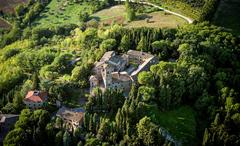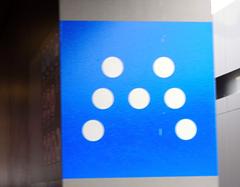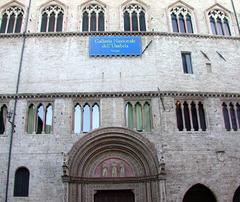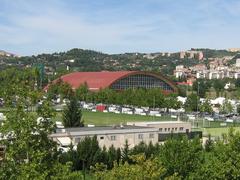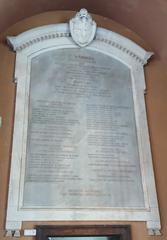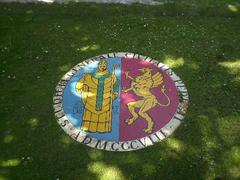
Teatro Morlacchi, Perugia: Visiting Hours, Tickets, and Historical Significance
Date: 04/07/2025
Introduction
Teatro Morlacchi, located at the heart of Perugia, Italy, stands as one of the city’s most iconic cultural landmarks. Since its inauguration in 1781, the theater has played a pivotal role in shaping Perugia’s artistic and civic identity. Its elegant neoclassical architecture, storied past, and vibrant contemporary programming make it a must-visit destination for both local residents and international visitors. Today, Teatro Morlacchi continues to bridge centuries-old traditions with modern innovation, offering a diverse calendar of performances, educational workshops, and community events. This comprehensive guide provides detailed information on the theater’s history, architectural highlights, visiting hours, ticketing, accessibility, and nearby attractions, ensuring you make the most of your visit to this remarkable venue.
Table of Contents
- Historical Background and Architectural Evolution
- Dedication to Francesco Morlacchi
- Artistic Flourishing and Social Significance
- Wartime Challenges and Postwar Revival
- Modern Renovations and Current Use
- Visiting Hours, Tickets, and Accessibility
- Travel Tips and Nearby Attractions
- Special Events and Guided Tours
- Frequently Asked Questions (FAQ)
- Visual Highlights
- Summary and Staying Updated
- References
Historical Background and Architectural Evolution
Teatro Morlacchi was conceived in the late 18th century as a response by Perugia’s burgeoning bourgeoisie to the aristocracy’s Teatro del Pavone. Ninety local families pooled resources to establish a theater that would democratize access to the performing arts. Construction began in 1778, under the direction of Perugian architect Alessio Lorenzini, who was tasked with fitting a grand auditorium into the limited confines of a former cloister. Lorenzini’s innovative horseshoe-shaped design, with five tiers of boxes and a compact yet elegant façade, reflected both the spatial constraints and the social ambitions of its founders (Wikipedia, World City Trail, TMA Italia).
Inside, lavish decorations combine late Baroque and early Neoclassical elements. Notable artists such as Baldassarre Orsini painted the original ceiling and curtain, while Carlo Spiridione Mariotti and Giovanni Cappelli contributed medallions, cameos, and ornate box parapets. The theater’s layout, with boxes initially reserved for founding families, embodied the social hierarchies of its era.
In 1874, architect Guglielmo Calderini led a major renovation that expanded the structure, introduced new sculptural and pictorial decorations, and set the stage for the theater’s continued prominence. The curtain and ceiling were reimagined by Mariano Piervittori, with contributions from artists like Francesco Moretti and Matteo Tassi, while sculptors Raffaele Angeletti and Francesco Biscarini enhanced the stucco work (VisitAperugia).
Dedication to Francesco Morlacchi
The theater was renamed in 1874 to honor Francesco Morlacchi (1774–1841), a distinguished Perugian composer who served as Chapel Master of Italian Opera in Dresden. Morlacchi’s legacy, rooted in Italian operatic tradition, resonated with Perugia’s aspirations for cultural distinction. The renaming after major renovations marked a new chapter, aligning the theater with both local pride and international artistic achievement (Exploring Umbria).
Artistic Flourishing and Social Significance
From its inauguration, Teatro Morlacchi quickly became a focal point for the performing arts in Umbria. The theater attracted notable actors and musicians, reflecting the eclectic tastes of the period with productions ranging from classical drama to opera and ballet. More than an entertainment venue, it served as a gathering place for Perugia’s intellectual and social elites, fostering cultural exchange and civic engagement.
Wartime Challenges and Postwar Revival
The 20th century presented significant challenges. During the Fascist regime, censorship and political oversight limited artistic freedom. Under German occupation in World War II, the theater was requisitioned for troop entertainment, resulting in substantial damage and the suspension of its cultural mission (Exploring Umbria). After the war, the city administration initiated a comprehensive restoration between 1951 and 1953. Renovations included stage expansion, new technical galleries, rebuilt dressing rooms, upgraded facilities, and reinforced structural elements (TMA Italia).
Modern Renovations and Current Use
Today, Teatro Morlacchi accommodates 785 spectators across the stalls, five tiers of boxes, and a gallery—down from the original 1,200 seats to enhance comfort and safety. The theater hosts a wide spectrum of performances, including opera, ballet, contemporary theater, and international collaborations. Recent upgrades ensure modern amenities such as advanced lighting, sound systems, and climate control, all seamlessly integrated to preserve the historic ambiance (Ticket Italia, Umbria Tag24).
The Ridotto, a more intimate performance space within the theater, supports experimental works and close audience-artist interaction. Community initiatives, creative workshops for children, and accessible programming reflect Teatro Morlacchi’s commitment to inclusivity and cultural outreach.
Visiting Hours, Tickets, and Accessibility
- Visiting Hours: The theater is generally open Tuesday to Sunday, with box office and visitor services operating from 10:00 AM to 6:00 PM. Performance times are typically in the evenings; daytime access for guided tours may vary by season and event schedule. Always check the official website or contact the box office for current information.
- Tickets: Available online via Ticket Italia, at the box office, or through authorized platforms. Prices depend on event type and seat category, with discounts for students, seniors, and groups. Guided tour tickets are usually around €10.
- Accessibility: Teatro Morlacchi is wheelchair-accessible, with ramps, designated seating, and accessible restrooms. Audio-described performances and other accommodations are available for visitors with disabilities. For specific needs, contact the theater in advance (Umbria Tag24).
Travel Tips and Nearby Attractions
- Location: Centrally situated on Corso Garibaldi, the theater is easily reached by foot from Perugia’s main squares and public transport stops.
- Parking: Limited parking is available nearby; public transportation and walking are recommended, especially in the pedestrian-friendly city center.
- Nearby Attractions: Complement your visit with explorations of the National Gallery of Umbria, Piazza IV Novembre, Palazzo dei Priori, the Cathedral of San Lorenzo, and Rocca Paolina fortress. Perugia’s artisan markets and annual jazz festival also offer rich cultural experiences (The Tourist Checklist).
Special Events and Guided Tours
Teatro Morlacchi offers a dynamic calendar of events, including theatrical premieres, dance performances, concerts, and international festivals. Guided tours—available in Italian and English—provide insight into the theater’s architecture, history, and backstage operations. Special initiatives like “Mentre i grandi sono a teatro” offer workshops for children during main performances, fostering family involvement and arts education (Umbria Tag24).
Frequently Asked Questions (FAQ)
Q: What are Teatro Morlacchi’s opening hours?
A: Typically Tuesday to Sunday, 10:00 AM to 6:00 PM, with performances mainly in the evenings. Verify on the official website for special events.
Q: How can I purchase tickets?
A: Online via Ticket Italia or at the box office.
Q: Is the theater accessible for people with disabilities?
A: Yes, with ramps, accessible seating, and audio-described shows. Contact the theater for specific accommodations.
Q: Are guided tours available?
A: Yes, offered occasionally and during major events. Advance booking is recommended.
Q: What are the best nearby attractions?
A: Piazza IV Novembre, National Gallery of Umbria, Palazzo dei Priori, Cathedral of San Lorenzo, and Rocca Paolina.
Visual Highlights
Alt text: Exterior view of Teatro Morlacchi, Perugia’s historic theater
Experience the elegance of Teatro Morlacchi’s historic interiors.
Enjoy summer concerts in beautiful historic settings.
Summary and Staying Updated
Teatro Morlacchi remains a cornerstone of Perugia’s cultural life, embodying a seamless blend of historical grandeur and forward-looking artistic programming. Its resilience through social transformation, war, and modernization reflects the enduring spirit of the performing arts. For visitors, comprehensive information on visiting hours, ticketing, accessibility, and events is available via official channels. Enhance your experience by downloading the Audiala app, which provides up-to-date schedules, ticket booking, and guides to Perugia’s cultural sites.
Stay informed about upcoming events and exclusive opportunities by following Teatro Morlacchi and Audiala on social media. Immerse yourself in the legacy and vibrancy of Perugia’s premier theater—where history, community, and creativity converge.
References
- Teatro Morlacchi Visiting Hours, Tickets, and History - Perugia’s Iconic Theatre, Exploring Umbria
- Teatro Morlacchi season 2025/2026, Umbria Tag24
- Teatro Morlacchi in Perugia, Ticket Italia
- Teatro Morlacchi Information and History, World City Trail
- Teatro Morlacchi Restoration and Details, TMA Italia
- Teatro Morlacchi Cultural and Visitor Information, The Tourist Checklist

